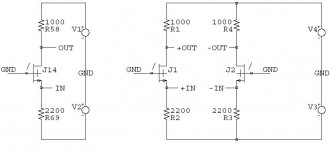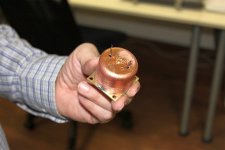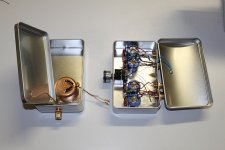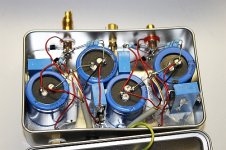Well i go two roots with the shunts. My friend Brian Daley in the states makes a 75 Ohms 4 layer board from HF material right now and i will do the dead bug style. If they do not love each other they will be married against their will.
I see determination!


Anyone tried these, I didn't search just curious. Maybe we could all meet for a Herman Nitsch "Action".
You have used such on carts already Scott?
You have used such on carts already Scott?
No, but I see little difference from making a Vbe up from ground to bias a common base stage. the second one does not have this problem. The chance of me buying a new MC cartridge are slim, so just asking.
PP tube amplifier
this is a swiss design.
well actually i have a more philosophical idea that too much symmetry is no good for life. Perfect symmetry is dead. I found that when i layout my cables in a way they fall into their natural position they sound better. I just lift them from the floor and let them fall gently. I also found that too much dirt is not good but sterile rooms are even worse sounding. Maybe time is asymmetric. It pushes everything forward and allows no rest.
Joachim I agree there is something with this "not so perfect" thing, there is something special with the asymmetric, it also creates even order distortion that is much more benign for our ears.
I have now started a tube amplifier project, is going to be my first tube amplifier so I am very excited about it, in the past I thought symmetry is the "answer" to perfection of Audio Nirvana, but in this design we won't see so much of it, it seems when one becomes older one matures also in thinking and general life philosophy and the same goes for audio designing philosophy.
Actually my friend Jürgen Ultee designed the Duelund resistors. They are from carbon rods.
Carbon rods, are these similar to composite resistors which are known to be noisy, sensitive to humidity and can change and at worst case irreversible changed in the resistance when they are soldered and heated too much?
Carbon or graphite, it is the different name for same thing and very similar to the lead pen, yes sala you could perhaps install led pen in your amplifier?
Cheers Michael
I do remember from many many years ago in my youth back in school I took a led pencil and run high current through it, it started to smoke, the conclusion was it "worked"! 
Well, in fact from safety point of view composite resistors are in fact very dangerous if over heated and start to burn, it's almost explosive and not recommended where reliability and safety is a concern as the flame development is so hefty it can make anything around start to burn so I hope people who use these resistors in loudspeaker which is often made of wood take this into consideration and I am not joking.
Cheers Michael
Well, in fact from safety point of view composite resistors are in fact very dangerous if over heated and start to burn, it's almost explosive and not recommended where reliability and safety is a concern as the flame development is so hefty it can make anything around start to burn so I hope people who use these resistors in loudspeaker which is often made of wood take this into consideration and I am not joking.

Cheers Michael
well you know, my safety consultant told me once there was a guy who brought home his new mega amplifier with huge output wattage which he connected to his loudspeaker with shy power ratings but which of course had a nice x-over with composite resistors speced for the loudspeakers max rating, now his amplifier was made for driving an arena speakers set-up, the volume knob had three gradings in ascending order "Min", "Max" and "Are you nuts?".. and of course he had to find out the truth.
The story tells also he had to call the fire-brigade to quench the fire, afterwards one of the fire-brigade men asked him what caused the fire and the guy told he just bought a new amplifier he wanted to test.. the fireman asked the guy "are you nuts?"
The story tells also he had to call the fire-brigade to quench the fire, afterwards one of the fire-brigade men asked him what caused the fire and the guy told he just bought a new amplifier he wanted to test.. the fireman asked the guy "are you nuts?"
Jürgen made them so they compensate for the temperature coefficient of dome tweeters. they are big, more then 10cm long and in an impregnated paper tube. but somehow he is not totally happy with them. other people love them.
Today i will send some photos and measurements.
First i show the copper cased coils, the inductive RIAA, the PSG and the Hiraga Optime.
Today i will send some photos and measurements.
First i show the copper cased coils, the inductive RIAA, the PSG and the Hiraga Optime.
Attachments
Here come some measurements of the Hiraga Optime with Telepath MM RIAA stage. Distortion is 2nd only, monotonic. OHH sorry, somehow the files got over 1MB big. I try later or tomorrow. i plan to listen a bit today because i also now mounted coils on the powersupply of the Telepath and i am eager to hear the result.
but somehow he is not totally happy with them. other people love them.
Are those resistors used in Peak Consult loudspeakers of Denmark?



